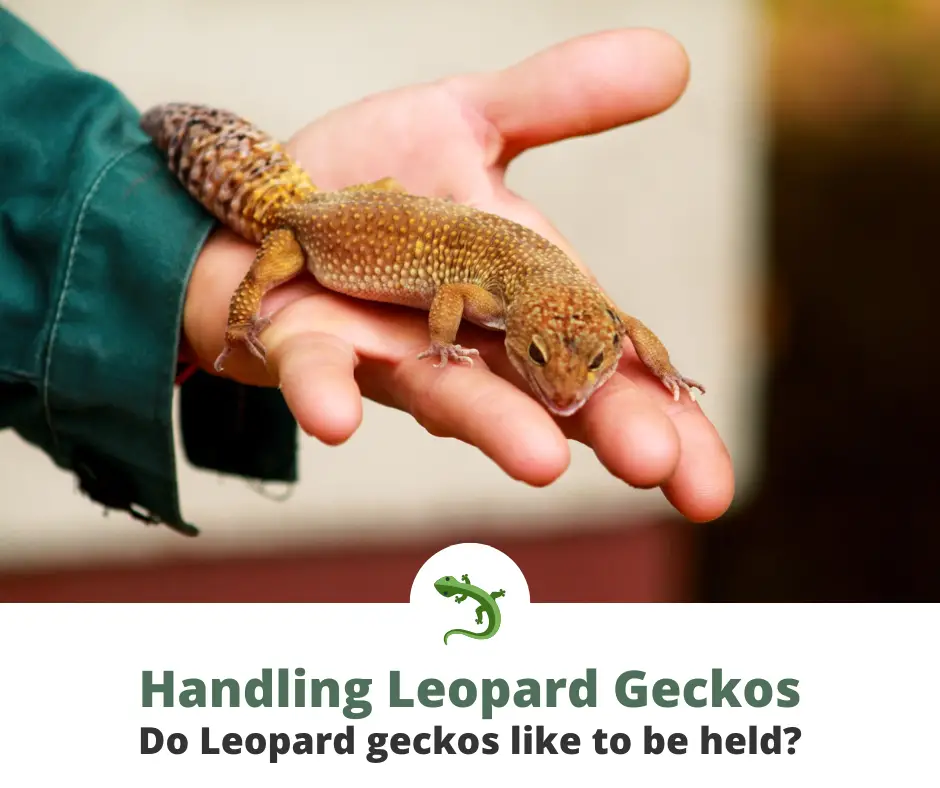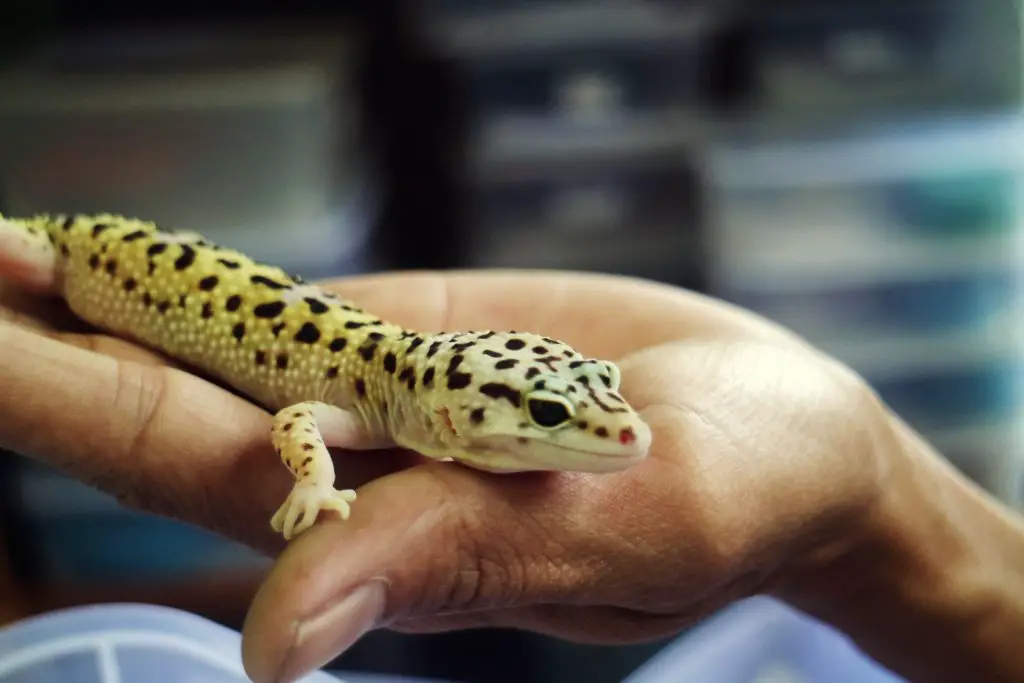In this guide, you’ll learn:
- Do Leopard geckos like to be held?
- Tips for safe handling
- Precautions to take during handling

Do Leopard Geckos Like To Be Held?
Leopard geckos will tolerate being held, but they probably don’t like it. It can be stress-inducing and reptiles should never be forced to be held. If you want a pet you can handle often, reptiles may not be a great fit for you.
Remember, trusting something bigger than they are is going against their survival instincts, especially for a small creature. Being held is not always an experience a reptile will look forward to but they can learn to build trust with their owners which allows handling to become stress free.
Some reptiles, like Leopard geckos and bearded dragons, do have a more docile and calm temperament and will get used to being held more quickly than others.
Some owners report “cuddling” or some sign of affection from their reptiles. However, this is most likely a combination of comfort or tolerance of handling and heat-seeking behavior from a reptile.

What’s The Best Way To Handle Your Leopard Gecko?
The golden rule with handling Leopard geckos is to be very careful with their tails since they can drop them when threatened or stressed. Never pick them up by their tails, and be sure to support their whole body when you hold them. Have a gentle but secure grip. Holding the gecko on your palm with the other hand supporting it is the best way to handle it.
You should always aim to have your pet associate handling with a positive experience. The trick is to go at your gecko’s pace and be patient. It’s also good to remember that while most Leos easily learn to like being held, it still depends on the individuality of your animal.
Pro-Tip ⚡
The best way to get your Leopard gecko used to your presence is to hold it a bit before feeding time so that it associates your presence with food and, thus, a positive experience.
Handling training should be started as early as possible but after 4-5 months of age or once they’re juveniles. Hatchlings and babies may be too skittish and sensitive to start being held too much.
📚 Read More >> Leopard Gecko Cost Guide
8 Tips For Properly Handling Your Leopard Gecko
- Be patient and go at your gecko’s pace.
When handling reptiles, it’s best to be patient and go at your gecko’s pace. Slowly introduce your presence to your gecko, so it gradually becomes acclimated. A few minutes of handling time a day is enough. Do not overdo it to avoid stressing your gecko out. Handling sessions shouldn’t be longer than 10-15 minutes a day.
Pro-Tip ⚡
Obtain your reptiles from responsible breeders who will take the time to get their reptiles used to human presence at a young age. This will make it easier for you to build trust when you first get your reptile.
- Build trust using food.
Another great way to build trust is to let your gecko associate your presence with food which is a positive experience. Try keeping your hand inside the enclosure as your gecko feeds or practice handling a few minutes before its feeding time.
- Let it explore on its own.
Always let your gecko initiate interaction and never force anything upon it. You can try holding out your hand near its chin and letting it sniff and approach you on their own. Slowly, your gecko will naturally climb your hand as it explores and it may even lick you as it tries to make sense of its surroundings.
- Make sure your gecko is calm.
Make sure your gecko is not visibly stressed or scared when you handle it. Watch for any tense or hunched body position, as if ready to attack, as you approach. Leopard geckos will usually hunch up in all fours as a defensive response or as a sign of aggression. If this is the case, allow your gecko to calm down before trying to handle it again.
Avoid startling your Leopard gecko by making sure it is aware of your presence before you pick it up.
- Provide a hiding place in its enclosure.
Leopard geckos and other small lizards use burrows, hides, and small caves in their natural habitat to hide in when they feel threatened. It’s important that they also have something similar to these areas in their tank so they can feel safe. Obstacles or interesting objects to explore will also help stimulate your gecko’s curiosity which helps it become at ease easier with foreign objects.
As you train your gecko to become used to being held, it will get stressed especially during the first few weeks of training. They should have a safe space they can hide in to calm down. This avoids the build up of chronic stress which can lead to different health issues in reptiles.
- Choose a safe handling space
Avoid any accidents while you train your lizard to get used to handling by making sure the space is safe. Don’t hold them too high above the ground to avoid injury in case they squirm out of your hands. If possible, work near the floor or a table with side guards so they don’t fall off it in case they scuttle away.
- Support its body while handling
Use both hands to hold your gecko, making sure to support its whole body. Never pick it up by it’s tail and always supports its belly and limbs. It’s usually best to allow your gecko to climb onto your hand instead of picking it up. Don’t put any full pressure as you grasp it. Use a gentle but secure grip.
If your gecko tries to squirm away, do not hold it tighter. Stay calm and gently bring it down into its cage or the floor. A frightened gecko will not likely bite you, so don’t panic if it starts to squirm while you hold it. In any case, Leopard gecko bites are not expected to be painful.
- Avoid sudden movements
When interacting with any reptile, avoid sudden movements that can startle it. Make sure you approach it from a place where it can see you so as not to surprise it (e.g. do not pick your gecko up from above)
📚 Read More >> How Long Do Leopard Geckos Live?
Precautions To Take When Handling Your Leopard Gecko
Wash your hands before and after handling
Bacteria (e.g. Salmonella spp.) can grow on the surface of reptile skin especially when their enclosures are unkempt. These can transfer onto human skin and affect our health. Make sure you wash your hands before and after handling your Leopard gecko. This also ensures that no germs, parasites, or infections transfer from you to your reptile.
Clear the area and make sure it is safe
As a precaution, make sure that the area you’re handling your gecko in is safe from anything that can injure it. This includes protection from possible falls as it tries to squirm away from your hand so work with your gecko on the floor or on a table that is guarded on the side to prevent injuries.
You may also want to lay down a play mat or reptile carpet in the surface you plan to handle your gecko in to make it softer.
Conclusion
Reptiles generally do not take well to being held since these go against their natural instincts to avoid big predators. However, they are known to learn and build trust with their humans and as a result grow to tolerate handling with gradual training. Leopard geckos, with their docile and generally calm temperaments take to handling and human interaction much quicker than other reptiles and are reported to be more tolerant than most reptiles of being held.
FAQs
Do Leopard geckos like to be handled?
Yes, Leopard geckos learn to like being handled and are known for their calm temperament. Most Leopard gecko owners share that their pets tolerate handling pretty well.
However, all reptiles avoid things bigger than they are due to their survival instinct. Reptiles in captivity need to be acclimatized to human presence. Responsible breeders will initiate this as early as possible, making the process easier when you get your pet.
Are Leopard geckos good pets for kids?
Yes, Leopard geckos make good pets for kids due to their increased tolerance for handling, docile temperament, and relative ease of care.
Further Reading
Overview of Leopard geckos:
ADW: Eublepharis macularius: INFORMATION
Management and care of Leopard geckos:
MANAGEMENT, CARE, AND COMMON CONDITIONS OF LEOPARD GECKOS
Short article on care:
Leopard Gecko Husbandry and Nutrition
A detailed study on Leopard geckos:
Natural history and biology of hobbyist choice leopard gecko Eublepharis macularius
Article on Reptiles and their emotions:
Given the Cold Shoulder: A Review of the Scientific Literature for Evidence of Reptile Sentience


